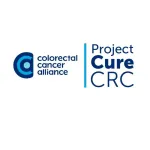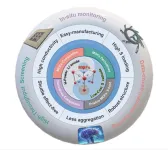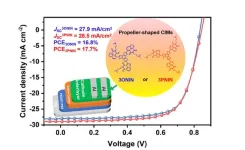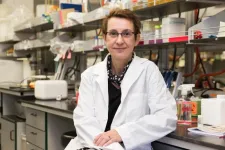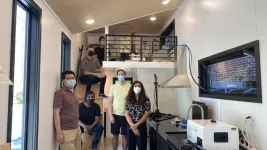(Press-News.org) OAK BROOK, Ill. – As artificial intelligence (AI) is increasingly used in radiology, researchers caution that it’s essential to consider the environmental impact of AI tools, according to a focus article published today in Radiology, a journal of the Radiological Society of North America (RSNA).
Health care and medical imaging significantly contribute to the greenhouse gas (GHG) emissions fueling global climate change. AI tools can improve both the practice of and sustainability in radiology through optimized imaging protocols resulting in shorter scan times, improved scheduling efficiency to reduce patient travel, and the integration of decision-support tools to reduce low-value imaging. But there is a downside to AI utilization.
“Medical imaging generates a lot of greenhouse gas emissions, but we often don’t think about the environmental impact of associated data storage and AI tools,” said Kate Hanneman, M.D., M.P.H., vice chair of research and associate professor at the University of Toronto and deputy lead of sustainability at the Joint Department of Medical Imaging, Toronto General Hospital. “The development and deployment of AI models consume large amounts of energy, and the data storage needs in medical imaging and AI are growing exponentially.”
Dr. Hanneman and a team of researchers looked at the benefits and downsides of incorporating AI tools into radiology. AI offers the potential to improve workflows, accelerate image acquisition, reduce costs and improve the patient experience. However, the energy required to develop AI tools and store the associated data significantly contributes to GHG.
“We need to do a balancing act, bridging to the positive effects while minimizing the negative impacts,” Dr. Hanneman said. “Improving patient outcomes is our ultimate goal, but we want to do that while using less energy and generating less waste.”
Developing AI models requires large amounts of training data that health care institutions must store along with the billions of medical images generated annually. Many health systems use cloud storage, meaning the data is stored off-site and accessed electronically when needed.
“Even though we call it cloud storage, data are physically housed in centers that typically require large amounts of energy to power and cool,” Dr. Hanneman said. “Recent estimates suggest that the total global GHG emissions from all data centers is greater than the airline industry, which is absolutely staggering.”
The location of a data center has a massive impact on its sustainability, especially if it’s in a cooler climate or in an area where renewable energy sources are available.
To minimize the overall environmental impact of data storage, the researchers recommended sharing resources and, where possible, collaborating with other providers and partners to distribute the expended energy more broadly.
To decrease GHG emissions from data storage and the AI model development process, the researchers also offered other suggestions. These included exploring computationally efficient AI algorithms, selecting hardware that requires less energy, using data compression techniques, removing redundant data, implementing tiered storage systems and partnering with providers that use renewable energy.
“Departments that manage their cloud storage can take immediate action by choosing a sustainable partner,” she said.
Dr. Hanneman said although challenges and knowledge gaps remain, including limited data on radiology specific GHG emissions, resource constraints and complex regulations, she hopes sustainability will become a quality metric in the decision-making process around AI and radiology.
“Environmental costs should be considered along with financial costs in health care and medical imaging,” she said. “I believe AI can help us improve sustainability if we apply the tools judiciously. We just need to be mindful and aware of its energy usage and GHG emissions.”
###
“Environmental Sustainability and AI in Radiology: A Double-Edged Sword.” Collaborating with Dr. Hanneman were Florence X. Doo, M.D., M.A., Jan Vosshenrich, M.D., Tessa S. Cook, M.D., Ph.D., Linda Moy, M.D., Eduardo P.R.P. Almeida, M.D., Sean A. Woolen, M.D., M.Sc., Judy Wawira Gichoya, M.D., M.S., and Tobias Heye, M.D.
Radiology is edited by Linda Moy, M.D., New York University, New York, N.Y., and owned and published by the Radiological Society of North America, Inc. (https://pubs.rsna.org/journal/radiology)
RSNA is an association of radiologists, radiation oncologists, medical physicists and related scientists promoting excellence in patient care and health care delivery through education, research and technologic innovation. The Society is based in Oak Brook, Illinois. (RSNA.org)
For patient-friendly information on medical imaging, visit RadiologyInfo.org.
END
February 27 — Five of the world’s leading research and education (R&E) networking organizations have joined forces to form MetrANOVA, a consortium for Advancing Network Observation, Visualization, and Analysis. Together, founding members Energy Sciences Network (ESnet), GÉANT, GlobalNOC at Indiana University, Internet2, and Texas Advanced Computing Center (TACC) operate and connect a dizzying number of national, regional, and local R&E networks — yet representing a portion of the decentralized fabric linking scientific researchers in hundreds of countries ...
Patients who have drug-resistant tuberculosis (TB) have a similar microbiological response to bedaquiline-based second-line medications as patients with drug-sensitive TB taking first-line regimens, according to researchers at Weill Cornell Medicine in New York and GHESKIO Centers in Haiti. Second-line medications are those that are given when one or more of the drugs given first for the disease are not effective. The research could have implications for shortening the duration of treatment for drug-resistant TB, which currently ...
In an effort to expedite its life-saving work, the Colorectal Cancer Alliance (Alliance) Project Cure CRC initiative is excited to open its Request for Proposals (RFP). Tens of millions of dollars will be available to researchers from around the world whose work aims to expedite colorectal cancer (CRC) research to a curable science. Beginning March 1, the program is accepting applications for one to three-year projects from qualifying professionals at research-based institutions and private companies. Priority will be given to proposals that focus on high-risk/high-reward projects to accelerate new CRC therapies and technologies from bench to bedside.
The ...
First-of-its-kind study suggests increasing the percentage of youth in the United States who participate in sports to meet a Healthy People 2030 goal could improve children’s physical and mental health and save $80 billion.
Achieving the Healthy People 2030 youth sports participation goal could save the United States $80 billion in direct medical costs and productivity losses and deliver over 1.8 million more quality years of life to Americans, according to a study that will be published on Feb. 27 in the American Journal of Preventive Medicine.
Every decade since 1980, Healthy People has provided science-based, 10-year national objectives and ...
Current lithium-ion battery technology does not have the energy density necessary to meet the demands for renewable energy. In theory, lithium-sulfur batteries could be a viable alternative with a higher specific capacity and energy density. However, sulfur has disadvantages that currently limit its practical adoption.
A comprehensive review published in Nano Research on February 8 outlines how metal organic frameworks-based cathode materials could improve the performance of lithium-sulfur batteries, making them a practical alternative to lithium-ion batteries.
“The ...
Imagine technology as a race car speeding down a track – it can only go as fast as its engine allows. But just when it seemed like organic solar cells hit a roadblock, along comes 3PNIN, a game-changing molecule shaped like a propeller, ready to turbocharge their progress and break through barriers.
Organic solar cells (OSCs) represent the pinnacle of renewable energy, yet certain components have fallen significantly behind the trajectory of ongoing development. Particularly, cathode interfacial materials (CIMs) have failed to sustain ...
BINGHAMTON, N.Y. -- Binghamton University, State University of New York researcher Karin Sauer is among 65 scientists elected as Fellows of the American Academy of Microbiology this year.
Fellows are elected by their peers based on their scientific achievements and original contributions to the field of microbiology.
Sauer’s lab aims to find ways to control communities of bacteria called biofilms and to curb their extraordinary resistance to antimicrobial agents. The team’s findings could have an impact on a wide range of healthcare practices, from ear infections to wound care.
“I’m honored and ...
Archeologists have long used the shapes and styles of pottery as a proxy for ancient cultures. But how does the cultural alignment of ceramic forms arise? To explore this question, Tetsushi Nonaka and colleagues asked 21 potters in three different communities—one in France in Bourgogne and two in India in Bulandshahar district, Uttar Pradesh—to throw pots with the same unfamiliar shapes. One of the Indian pottery workshops was Hindu, the other was Muslim. In each community, several different potters tried the shapes. Through careful measurement, the authors were able to determine ...
A study quantifies the emission of extremely tiny particles by gas stoves and finds that the particles could harm human health. Airborne nanoparticles between 1–3 nm, referred to as nanocluster aerosol or NCA, are known to be bioactive and toxic, but measuring such minute particles has been a challenge. Brandon E. Boor and colleagues measured indoor NCA during propane gas cooking in the Purdue zero Energy Design Guidance for Engineers (zEDGE) test house using a novel instrument. Combining measurement data with the general dynamic equation for aerosols, the authors were able to characterize the production and behavior ...
Continuous research is being conducted globally on using the Moon as an advanced base for deep space exploration, and Korea is no exception in these efforts. The Korea Institute of Civil Engineering and Building Technology (KICT, President Kim, Byung-suk) successfully implemented an electrostatic environment that simulates the Moon's surface conditions, not in space but on Earth. The researchers also assessed its performance and effectiveness.
Among the most serious threats in executing lunar missions is the Moon's surface environment, which is electrostatically charged. Due to its extremely thin atmosphere, the Moon is directly exposed to solar ultraviolet rays, X-rays, ...


